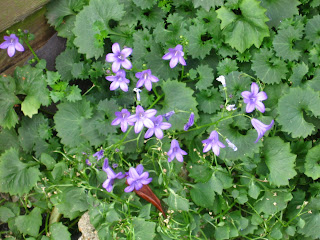 In this summer of extreme heat, and severe drought here in South Carolina, it's hard NOT to think about drought-tolerant plants. We have tried to establish a low-water use landscape, but that doesn't mean no water, especially with recently planted perennials, shrubs, and trees.
In this summer of extreme heat, and severe drought here in South Carolina, it's hard NOT to think about drought-tolerant plants. We have tried to establish a low-water use landscape, but that doesn't mean no water, especially with recently planted perennials, shrubs, and trees.
We've both gotten really tired of dragging the hoses around to water these young plants that we don't want to lose, but anything planted this year needs water to survive the high temperatures, hardly any rain, and too much wind conditions that we've had. Our plants would normally thrive, after establishment, on normal rainfall, but rainfall this summer has been anything but normal, and even the toughest drought-tolerant perennials have wilted in the late afternoon sun. Trees, with their much more extensive root systems, and shrubs haven't been much affected, and certainly reflect their higher drought-tolerance.
 Conditions this summer have me thinking about waterwise gardening (a 'new' alternative term for xeriscaping), as we basically don't believe that putting in irrigation systems is a sustainable option. I think the term 'xeriscaping' makes people think about desert landscaping or high elevation drought-adapted western plants, but I like the term 'waterwise gardening.' Even though I know we're hardly in the low rainfall zone at an average of 50" annually, our local cities and muncipalities are encouraging voluntary water use restrictions, and some are now mandatory in a severe drought year.
Conditions this summer have me thinking about waterwise gardening (a 'new' alternative term for xeriscaping), as we basically don't believe that putting in irrigation systems is a sustainable option. I think the term 'xeriscaping' makes people think about desert landscaping or high elevation drought-adapted western plants, but I like the term 'waterwise gardening.' Even though I know we're hardly in the low rainfall zone at an average of 50" annually, our local cities and muncipalities are encouraging voluntary water use restrictions, and some are now mandatory in a severe drought year.
Being a waterwise gardener means choosing plants that can withstand dry spells, and flourish without lots of supplemental water. Here in the SE, we can grow lots of great plants that fit that description. Clues to drought-tolerance come from native habitat (grasslands, prairies, dry woods, etc.), plant habit (deep tap roots or fibrous storage roots), leaf color and texture (gray leaves are reflective, waxy or thick leaves are water-loss resistant).
Some of my favorite 'tough plants' from this summer have been blazing star , purple coneflower, black-eyed susans, oakleaf hydrangea, Salvia species of all sorts (including the purple Salvia leucantha shown above, Vaccinium (blueberries), Rosemary, Nepeta (catmint) hybrids, garlic chives, anise-hyssop, and certainly all the native trees. Only the relatively thin-leaved tulip poplars, maples, and dogwoods have looked really stressed, where, in contrast, the oaks and hickories are looking fine.
, purple coneflower, black-eyed susans, oakleaf hydrangea, Salvia species of all sorts (including the purple Salvia leucantha shown above, Vaccinium (blueberries), Rosemary, Nepeta (catmint) hybrids, garlic chives, anise-hyssop, and certainly all the native trees. Only the relatively thin-leaved tulip poplars, maples, and dogwoods have looked really stressed, where, in contrast, the oaks and hickories are looking fine.
Lush leafy landscapes and abundant lawn grasses transpire large amounts of water and often need additional water added beyond the regular rainfall amounts.
I'm looking around and seeing what in our landscape might fall in that category. Fortunately, most of the native plants (perennials, shrubs, and trees) from this part of the U.S. are well-adapted to long periods of summer drought, and have been pretty nonplussed faced with weeks and weeks of no rain and extreme heat. The exceptions are many of our favorite plants that are native to the mountains, but not all of them. There are also some of our native understory trees that have large, thin, leaves and show water deficits quickly, too.
But, I do want to have a garden that I won't worry about if we're away in the summer and am not around to do water triage. Of course, my container plantings will be on their own, too, in that case, too!
Read more...




.jpg)

.jpg)
















































